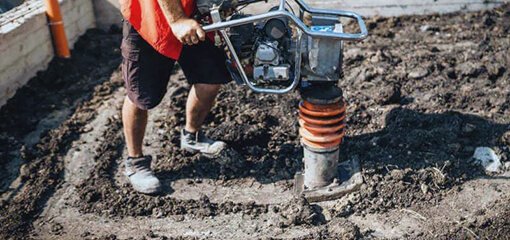13Jan 2023
table of contents

Soil compaction is one of the most critical parts of construction, the process of densifying soil by applying pressure to it also changes the soil structure from a loose, weak state to a denser, stronger state. Soil compaction can be accomplished with a variety of specialized compaction equipment.
Soil compaction is necessary to increase the load-bearing capacity and stiffness of in situ (natural state) or chemically modified soils. Compaction increases the shear strength of soil by increasing the friction created by interlocking particles. Reduces future soil settlement by increasing stiffness and eliminating voids that create compacted soil. Removing voids reduces the chance of soil settling or shrinking or swelling, and reduces water infiltration that can cause detrimental shrinkage and swelling soil properties. Shrinkage/expansion properties can damage the pavement structure, leading to premature failure of the pavement structure.
Key long-term benefits include:
Increase load capacity
Reduce settlement
Better stability
Reduce water seepage
Reduce shrinkage
Now, anywhere soil needs to be moved for construction, the foundation starts with soil compaction. And these portable tamping rammers, forward and reverse vibrating plates, and smaller trench rollers are common equipment for narrow-area work such as trench backfill, curbs and gutters, bridge supports, slab works, and sidewalks soil compaction.
Different types of soil respond differently to compaction. Soils are classified by particle size and, in some soil classes, by critical moisture content values or Attberg limits. Well-graded granular soils containing a variety of particles are preferred in construction applications because they can be easily compacted, eliminating voids and resisting moisture absorption by interlocking particles, making the soil as a very dense soil able to withstand more large loads. Poorly graded soils contain a narrow range of particle sizes, which is not good for construction purposes because the soil lacks the shear strength associated with non-interlocked particles, so it is not easy to compact.

Moisture content plays a very important role in soil compaction. Maximum dry density can only be achieved when the moisture content is at the desired level. This point is known as the optimum moisture level. If the soil is below its optimum moisture content, a calculated amount of water should be added to the soil using a sprinkler attached to a water tanker and mixed with the soil by a grader to achieve an even moisture content.
If there is excess soil moisture, the recommended requirements are aeration and drying to achieve optimum moisture levels.
The type of compaction equipment you choose also varies slightly, depending on the type of soil that needs to be compacted. The table below can be used as a reference to determine the type of equipment for different types of soil.
| Compaction Equipment | types of soil that can be compacted |
| plate compactor | gravel |
| roller | sand, gravel, silty soil, clay |
| tamping rammer | soil in a confined space |
Soil compaction sometimes involves compacting multiple soil layers, or multiple soil layers, until a desired total thickness is achieved. Each lift is only as stable as the lift below it, so the compaction of each layer is critical and must be monitored. Establishing the correct lift thickness is important in finding the balance between layers that are too small or too large. Too large a lift can cause poor compaction and affect stability, while too small a lift can lead to excessive cost and time. Lift thickness is usually between 8 and 14 inches depending on specification.
The contact pressure between the soil and the compaction equipment is also important. Contact pressure is affected by the total weight of the compaction equipment and the area of soil that the equipment contacts. The higher the contact pressure, the higher the degree of compaction achieved.
Many factors affect compaction, but the most fundamental factor is the type of soil being compacted and its water holding capacity. The soil must be tested to see if it is suitable for compaction.
There are several compaction testing methods that can be used to determine the degree of compaction. Preliminary field testing at the project site is important to understand the conditions that initially existed. Sand cone testing, using a balloon densitometer, or a Shelby tube are all viable options, but a nuclear densitometer is most commonly used to test the compaction of a site. Laboratory methods typically involve compacting soil into molds at 25°C to obtain soil density. For example, a moisture density test specifies compacting soil from a specified height using a standard weight in a mold of a specified volume. These requirements facilitate controlled and repeatable compaction forces and provide maximum density and optimum moisture content of the soil.
Soil compaction is achieved by static or dynamic forces and manipulations of the soil. Statics use the machine's own weight to apply continuous pressure downward, increasing compaction by compressing the top of the soil. Dynamic forces use motion in the form of vibrations or dropping weights combined with the static load of the machine to increase the density of the soil. Work through kneading and shearing to help compact the soil at a deeper level.
BISON has equipment specially designed to compact loose soil, whether cohesive (such as clay) or granular (such as gravel), to form a stronger, more compact soil. Equipment ranges from hand compactors to very large, very heavy rollers. These devices can be found at BISON light construction equipment suppliers.
inquiry form here
BISON BLOG, All the latest news and views from Bison Machinery.
Related Products